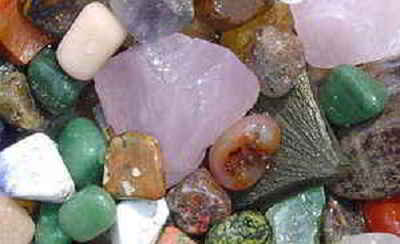Michigan State Gemstone or Gem
Chlorastrolite (aka Isle Royale Greenstone)

Ca2(Mg,Fe)Al2(SiO4)(Si2O7)(OH)2?H2O - Chlorastrolite)
Adopted on March 30, 1973.
Michigan State Gemstone is chlorastrolite, a variety of the mineral pumpellyite. It also goes by the common name of greenstone or Isle Royal greenstone. The term greenstone can be confusing in that it is both a rock and a mineral term.
Chlorastrolite is found chiefly as small rounded beach pebbles showing a finely radiating or stellated pattern of slender crystals. The masses, colored pink to green to black or mottled, are derived from nodular vesicle fillings in the amygdaloidal basalts of the copper country and were formerly found in relative abundance, particularly on Isle Royale beaches.
Chlorastrolite was named the "Official State Gem" of Michigan by the Seventy- Sixth Legislature (Act 56, PA 1972, effective March 30, 1973).
Isle Royale greenstone: Michigan State Gem

Chlorastrolite also known as Michigan Greenstone, is a green or bluish green stone. Chlorastrolite has finely radiated or stellate masses that have a "turtleback" pattern. The stellate masses tend to be chatoyant, meaning they have a changeable luster. This chatoyancy can be subtranslucent to opaque. Chlorastrolite is a variety of pumpellyite
Chlorastrolite is found chiefly as small rounded beach pebbles showing a finely radiating orstellated pattern of slender crystals. The masses, colored pink to green to black or mottled, are derived from nodular vesicle fillings in the amygdaloidal basalts of the copper country and were formerly found in relative abundance, particularly on Isle Royal beaches.
Pumpellyite is closely related to the epidote family. It is widespread low-grademetamorphic mineral (particularly in glaucophane schists) and a hydrothermal mineral inaltered mafic igneous rocks (like basalts, and diabases). Originally the mineral was described in 1901 by Murgoci under the name of lotrite from the southern Carpathian Mountains. The writer was enabled to examine the handwritten notes of his former Harvard professor, Charles H. Palache, who in 1920 made the first systematic study of the secondary minerals in the altered copper lodes for the Calumet and Hecla Copper Mining Company. Palache notes the widespread and abundant nature of a "green zoisite." Shortly after this initial study, Palache realized his green zoisite was not a zoisite but believed it to be a new mineral closely related to the zoisite-epidote family. Unfortunately he had not encountered Murgoci's (1901) description of lotrite. Palache submitted amanuscript to Calumet and Hecla describing the "new" mineral proposing to call it "kearsargeite."

B. S. Butler didn't like the name and Palache changed the manuscript by crossing out kearsargeite and penciling in "pumpellyite," in honor of Raphael Pumpelly, a noted 19th century US Geological Survey geologist who made many contributions to theknowledge and understanding of copper minerals and the copper deposits of the Keweenaw Peninsula. Chlorastrolite is now known to be a variety of pumpellyite. This was first verified by W. B. Griffiths at the University of Michigan in the late 1940's (personal communication) Previously, chlorastrolite had been considered 1) an independent species,2) a variety of prehnite, or 3) a variety of thomsonite.
Michigan Laws
The law designating the greenstone as the official Michigan state gem is found in the Michigan Compiled Laws Chapter 2 (STATE) Act 56 of 1972 Statute.
Act 56 of 1972
Statute STATE GEM (2.17 - 2.17)
STATE GEM
AN ACT to adopt chlorastrolite as the state gem.
2.17 State gem.
Sec. 1.
Chlorastrolite, commonly known as greenstone, is adopted as the official gem of this state.
History: 1972, Act 56, Eff. Mar. 30, 1973
Minerals, & Gems

Gemstone, Minerals, Rocks







